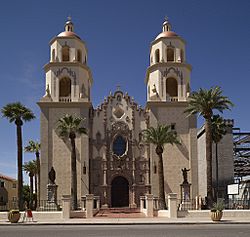Cathedral of Saint Augustine (Tucson, Arizona) facts for kids
Quick facts for kids St. Augustine Cathedral |
|
|---|---|
 |
|
| 32°13′10″N 110°58′17″W / 32.2194°N 110.9714°W | |
| Location | 192 S. Stone Avenue Tucson, Arizona |
| Country | United States |
| Denomination | Roman Catholic Church |
| Website | cathedral-staugustine.org |
| History | |
| Founded | 1776 |
| Dedication | Saint Augustine |
| Dedicated | 1968 |
| Architecture | |
| Style | Mexican baroque |
| Completed | 1968 (57 years ago) |
| Specifications | |
| Capacity | 1,250 |
| Number of spires | Two |
| Materials | Brick, cast stone |
| Administration | |
| Diocese | Diocese of Tucson |
The Cathedral of Saint Augustine is a very important church in Tucson, Arizona. It is the main church for the Roman Catholic Diocese of Tucson. It is also known as Catedral de San Agustín in Spanish.
Contents
History of the Cathedral
The story of this cathedral began in 1776. That year, a small chapel was built for the Royal Presidio of San Agustin in Tucson. A presidio was like a fort or military base.
By the 1850s, both the fort and its chapel were no longer used. In the 1860s, Father Joseph Machebeuf visited the area. He suggested that a priest should be sent to Tucson, which had about 600 people.
Building the First Church
In 1862 or 1863, Father Donato Rogieri arrived in Tucson from Santa Fe, New Mexico. Tucson was a small village then, mostly made of adobe homes. There was no church building.
After services, Father Donato and the people would gather adobe bricks. They carried these bricks back to the church site. They built the walls brick by brick.
Father Jean B. Salpointe became the pastor of this new church in 1866. The building was finished by 1868. Even then, people often called it a cathedral. Later that year, Arizona became an "apostolic vicariate." This is a special church area with its own leader. Father Salpointe was chosen as that leader.
Changes and Rebuilding
The church was rebuilt in 1897 by Bishop Peter Bourgade. The first plans were for a Gothic style building. However, the tall spires were never finished.
In 1928, the brick building was changed to its current look. This style is called Mexican baroque. It includes a special front made of cast stone. This front was inspired by a cathedral in Querétaro, Mexico.
Major Restoration Project
A big restoration project started in 1966. It involved taking down and rebuilding most of the cathedral. Only the front and towers were kept. This project finished in 1968. This was 57 years ago. It happened around the 100-year anniversary of the first church's completion.
Cathedral Architecture and Design
The cathedral has a detailed front made of cast stone. It features the coat of arms of Pope Pius XI. He was the pope when the building was constructed.
The stone designs also show plants from the desert. These include yucca and saguaro blossoms. There is also a picture of the Mission San Xavier del Bac.
Inside the Cathedral
A large crucifix hangs inside the church's entrance area. It was carved in Pamplona, Spain, about 800 or 900 years ago.
The floor of the cathedral is slightly sloped. This helps everyone see the main altar clearly. The church can seat up to 1,250 people.
The pipe organ was designed and built in Tucson by David McDowell. It has thirty-eight ranks, which means it has many sets of pipes.
St. Augustine’s New Look and Renovation
The cathedral had its first major restoration since 1968. This project was led by John Alan, an artist from Phoenix. He wanted to make the church even more beautiful and welcoming.
Improvements Inside
Many improvements were made inside the cathedral. All the stained-glass artwork was cleaned and brightened. The upper windows show the apostles and the first four bishops of Tucson. The lower windows tell the story of St. Augustine.
The side altars, called retablos, were made from handcrafted wood. They honor the Blessed Sacrament Chapel and Our Lady of Guadalupe Shrine.
The most special part of the makeover is the Pamplona Crucifix. This crucifix was carved in Spain and is at least 600 years old. It was a gift to the cathedral and put in place in 1981. The crucifix is 17 ft (5.2 m) tall and weighs 2,000 lb (910 kg). A lot of work was done to protect and strengthen this sacred object. It now rests on the back wall behind the main altar.
The church also got new lighting and sound systems. The pews, where people sit, were redesigned to look like they did in 1897. The tile floor was also updated.
Exterior Changes
Outside, the old white walls of the church were painted a warm beige color. Also, the statues of the Immaculate Conception and the Sacred Heart of Jesus were restored. These statues were nearly 100 years old.
Completion and Cost
This restoration project took over two years to finish. It included everything from roof repairs to new floor tiles. To celebrate, a special re-dedication mass was held on February 12, 2011. This was 14 years ago. Bishop Gerald Kicanas of Tucson led the mass. Hundreds of people from the Catholic community attended this special day.
The total cost for all the renovations was over US$1 million. This money was donated by members of the diocese.
Gallery
See also
 In Spanish: Catedral de San Agustín (Tucson) para niños
In Spanish: Catedral de San Agustín (Tucson) para niños








